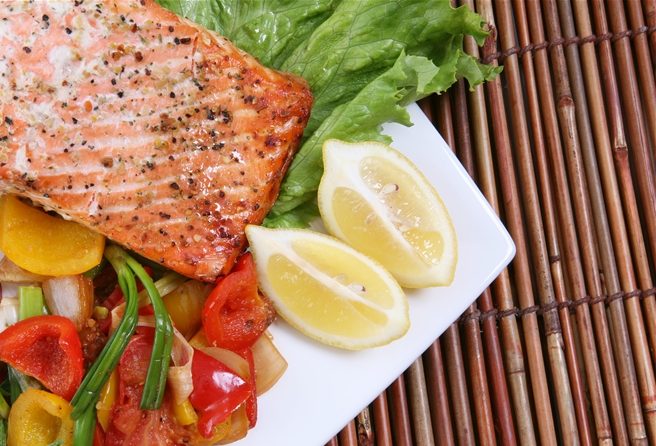When you consult with a pain management specialist for your chronic pain, your physician may recommend one or more of various treatment protocols, depending upon your individual pain condition.
Your pain doctor may recommend options such as exercise/physical therapy, activity restrictions, minimally invasive procedures or pain medication, or any combination of these as called for by your specific pain diagnosis.
But regardless of which treatment regimen is right for your situation, there’s one common action your pain physician will most likely recommend: eat a healthy diet.
The relationship between food and chronic pain is well established; substantial relief can often be achieved by simply eating the right foods, in the right portions, and avoiding other foods altogether.
One of the most notorious contributors to chronic pain is inflammation. Inflammation can damage the body’s cells and organs, and cause constant pain in joints, muscles and tissues.
For example, arthritis pain is caused by inflammation in the joints; osteoarthritis pain by inflammation in the bone. By reducing or counteracting inflammation, pain may be reduced or even eliminated, depending on the pain condition.
Fortunately, there are many natural foods that help to reduce inflammation and ease pain over time. While your pain doctor will know best which specific diet to recommend for your condition, here are some foods that are well-known to help reduce inflammation:
- Whole grains
Examples: Whole grain bread or pasta, rye bread, oats, brown rice, barley, bulgur, quinoa
- Beans, nuts, seeds, pods
Examples: Black, white or kidney beans, chick peas, walnuts, almonds, sunflower seeds, peas, soybeans
- Vegetables
Examples: Spinach, leafy greens, cabbage, onions, garlic, broccoli, radishes, cucumbers, green beans
- Fresh Fruits
Examples: Berries, pomegranates, cherries, strawberries, citrus
- Fish
Examples: Wild salmon, sardines, herring, anchovies, mackerel
- Fowl
Examples: Chicken, turkey, Cornish hens, pheasant, quail
- Olive oil
A healthier alternative to use in place of butter or other cooking oils
- Herbs & spices
Examples:
Garlic, ginger, cinnamon, turmeric, rosemary, cayenne pepper, black pepper - Tea
Examples: Black, white, green or herbal tea
Avoid these foods that are common culprits for increasing inflammation:
- Red meat
Examples: Beef, including steaks, ribs, ground beef, burgers
- Processed meat
Examples: Bacon, ham, sausage, lunch meat
- Nightshade vegetables
Examples: Potatoes, tomatoes, eggplant
- Unhealthy oils and fats
Examples: Shortening, margarine, lard, oils such as soybean, safflower, sunflower and corn oil
- Sugary foods
Examples: Pastries, cookies, cakes, donuts, brownies, muffins, pies
- High-fructose corn syrup
Examples: Candy, sweetened yogurt, salad dressing, canned fruit, carbonated drinks
- Sugary drinks
Examples: Soda, fruit juice, energy drinks, sweetened tea or coffee
- White bread
- White or instant rice, packaged stuffing
- Instant oatmeal
- Rice & corn-based cereals
- Alcohol
- Coffee creamer
Here are some additional general guidelines for eating habits that help diminish chronic pain:
- Drink plenty of water, which is essential for utmost well-being regardless of your level of health.
- Avoid foods that cause blood sugar ‘spikes’, such as white bread, processed or sugary foods.
- Avoid grilled, broiled, seared or and fried foods, which are all cooked at high temperatures that brown or char and produce unhealthy compounds.
- Avoid foods high in saturated fats, (such as fatty meats, fried foods and butter). Instead, switch to whole grains and more fish, and reduce red meat intake.
- Ensure that your diet includes antioxidants, (such as strawberries, nuts or dark green leafy vegetables,) Omega-3 fatty acids, (tuna, salmon or sardines,) and Vitamin C, (citrus fruits or broccoli.)
- Maintain a healthy body weight. Not only does obesity cause added strain on damaged muscles and joints, but excess fat cells also contribute to inflammation. Eating a healthy diet will help control your body weight and further aid in pain reduction efforts for a better overall feeling of wellness.
While these are general guidelines, it is highly recommended that before beginning any specific type of diet, those suffering from chronic pain should first consult with a qualified pain management physician to determine the source of your pain, and which dietary recommendations are indicated for your individual situation.
Are You Living with Chronic Pain in Florida?
Florida Pain Relief Centers’ board-certified physicians are equipped with state-of-the-art technology and take a comprehensive, multimodal approach to treating your chronic pain.
Our pain specialists maintain a focus on providing comprehensive, personalized care for each patient to determine the best treatment option for your unique pain condition. At FPRC, our top priorities are relieving your pain and ensuring your comfort.
If you’re tired of suffering and want more information about options to reduce or eliminate your pain, call Florida Pain Relief Centers today at 800.215.0029 or click the button below to schedule your visit online.


